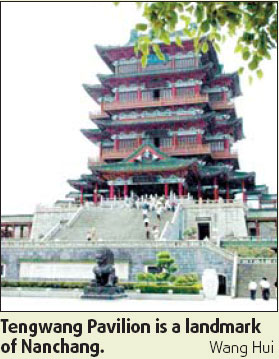Scorching heat, drenching plum rains, characterize Nanchang
I told myself I would be finally rid of this weather as I buried myself in preparations for the 1983 college entrance examination, in the simmering heat of July.
The steady all-day drizzle of the previous months always drenched me to the skin. I hated to take a stick-like umbrella - we did not have folding type at that time. It was the plum rain season - or meiyu, in Chinese. This intermittent drizzle is a meteorological feature unique to the middle and lower reaches of the Yangtze River, where my hometown Nanchang sits.
When the plum rain season started in March, I found that almost everything in our apartment was wet. I could feel and smell the dampness of the quilt when lying in bed. I felt I could squeeze out water if I clenched my fist tight enough. Before the season ended in May, the continuous drizzle had driven me crazy - there was hardly any breeze and it felt so stuffy.
The temperatures ran high - 40 C for several days - at the height of the plum rains. It turned the city into one of the "four furnaces" - the other three being Nanjing, Wuhan and Chongqing.

A big square in the heart of Nanchang turned into a public "bed" for Nanchang residents - none of the apartments were equipped with air conditioners, only electric fans. The fans only made the hot air move faster, but did not cool it. So, at sundown, people carrying their bamboo mats raced to the square from every corner of the city for a patch of cool grass to lie down. The heart of the city looked neat and clean again the next morning, with the grass fresh and strong, showing no trace of "the bed".
Nanchang's winter is unbearably cold with chilly winds. My hands and feet always had chilblains no matter what kind of coat I wore to keep warm. Autumn is the only season good for outings.
Nanchang is not a common destination for travelers, not because of the weather but because of its undeveloped economy. However, it does receive some attention for its revolutionary history and for the Tengwang Pavilion - rebuilt at the site of the original tower in AD 659 - that stands on the shores of the great Ganjiang River. This 2,000-year-old city, capital of Jiangxi province, is known as the "City of Heroes" for being the birthplace of the Chinese People's Liberation Army.
There are some remarkable nooks and crannies filled with treasures for the interested traveler. Close to the train station in Xihu district stands Shengjin Tower, amid a veritable warren of side streets. The lanes around the tower are ancient, paved in stone and busy with merchants and pedestrians milling about. Standing above the glorious mess at what was once the outer wall of ancient Nanchang, the tower is bright white and encircled with bells that tinkle prettily above the crowds, creating an otherworldly soundtrack for the commerce below.
While the museums downtown present the revolutionary past of the city, a temple-turned museum on the outskirts of Nanchang hosts the artistic works of Zhu Da (also known as Bada Shanren).
He was a 10th generation descendant of Zhu Yuanzhang, the first emperor of the Ming Dynasty (1368-1644). He proved to be an artistic genius - and a notorious drunkard - early in his life. His exceptional freehand brush style added an uncommon flourish to his traditional Chinese painting technique.
The pretty museum on the shore of a small lake is perhaps the most relaxing place in all of Nanchang. Visitors can sit along a willow-lined walkway and admire Zhu's engravings or wander beneath the trees in the ancient temple courtyard lit amber in the sunlight, stepping into small alcoves where art works hang, telling of the wild mind that once occupied these halls.
Like the cuisine of neighboring provinces, Jiangxi food is spicy flavors; in many regions of the province, chili peppers are used as a vegetable instead of as a flavoring agent. They are supposed to relieve heat in the scorching summer - you will feel cool after sweating out the heat - and keep you warm in winter.
Chili peppers go with almost everything except soup, which every restaurant serves. Chefs put several small pots with water and duck, or chicken, or pig's foot and ingredients such as ginger and green onion into a large pot over a slow fire. It usually takes at least five hours to cook the soup.
I enrolled at a university in Beijing and have stayed here ever since. So I have rid myself of the plum drizzle, scorching heat and chilblains. Living in a northern city where a spatter of rain or snow can drive people wild, I sometimes miss my hometown's climate. Even the name for that uncomfortable rainy season - plum - has a poetic ring to it.
(China Daily 05/07/2008 page19)














